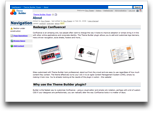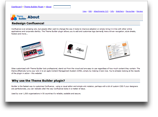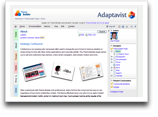[All Adaptavist Apps]
The Alternatives
There are four ways to customise Confluence, let's compare them...
Choose An Existing Theme
This is by far the simplest method - simply choose from one of the themes that come bundled with Confluence:
Screen grabs of our [About] page taken using Confluence 2.6.2, February 2008. Click thumbnails to enlarge.
The key disadvantage here is that these themes offer almost no customisation options. You can change basic colours and the Left Navigation theme allows you to add some custom navigation, but that's as far as it goes.
Customise Default Theme Layouts
The Confluence default theme (shown below) can be customised by editing the HTML/Velocity templates through the web interface:
– pics –
This gives you a fairly high degree of control because you can change the way most things look. If you're fairly experienced at using Velocity templates, you can also hard-wire macros in to the theme using this technique.
There's just a few downsides:
- If you do something wrong, you can break Confluence. Every single space administrator (including users with personal spaces) can edit the layouts and therefore break them - a support nightmare.
- Each time you upgrade Confluence, the layouts reset to their defaults so you have to go through the whole process again, taking in to account any changes Atlassian have made to the default layouts.
- You need HTML, Velocity and CSS skills to edit the layouts - generally a web developer will be required.
Create a Java Theme Plugin
If you've got Java developers on-hand, and they aren't swamped with other development tasks, you can create your own Java theme plugin:
– pics –
This method gives you 100% control over the way Confluence looks but is also the most complex and time consuming. It requires the most skilled people - Java, Velocity, XML, XHTML, CSS and JavaScript are just some of the technical skills required.
If you later upgrade Confluence, or want to change the theme design, you'll need to get Java developers in to make any required changes to the theme.
Use Theme Builder Plugin
We're obviously biased in thinking this is the best way to customise Confluence, however organisations in over 50 countries agree with us!
– pic –
Theme Builder aims to achieve all the benefits of the other three methods of customisation with none of the disadvantages...
Easily choose a layout
With the new layout chooser, space administrators can choose an existing layout quickly and easily - there's even a full preview of what their space will look like if they choose the layout:
Unable to render embedded object: File (choose-layout-full.png) not found.
Visual Customisation
The visual layout editor makes most tasks trivial:
– pic –
Easily customise panel content using wiki notation and macros:
– pic –
Extensive Control
With the ability to add custom CSS, custom macros (including any existing third-party macros), HTML and even Scriptix scripts to theme panels you can fine tune just the parts of the interface you need to instead of having to completely re-work the interface.
Upgrade Friendly
We've spent a lot of time ensuring that Theme Builder doesn't prevent you from upgrading Confluence.
As each new version of Confluence is released, our developers make sure the Theme Builder plugin is fully compatible allowing you to upgrade Confluence without worrying about the theme.
We've also been investing a lot of time and effort in making upgrades to future major versions of Theme Builder easier than ever before, with almost all settings automatically converted where necessary should we make any significant architectural alterations to the plugin. Theme Builder 3 and above include automated tools for porting layouts from the previous version (see System Administration).
And the rest...
Theme Builder is the only theme that caters to a wide range of requirements such as accessibility, navigation, return on investment and much more.



